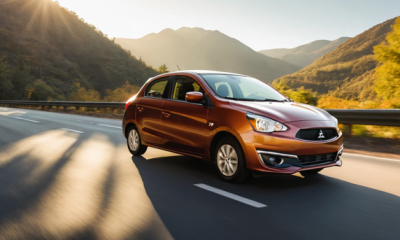Energy Efficient
What Is a Mild Hybrid System? Efficient Power Explained

What is a mild hybrid system? Learn how this smart technology boosts fuel economy and driving performance—without the plug.
What Is a Mild Hybrid System? Unlocking the Future of Fuel-Efficient Driving 🚗⚡
Curious if you can go hybrid without going fully electric? 🤔
You’re not alone! Many drivers want better fuel economy but aren’t ready to plug in a car every night. That’s where mild hybrid systems come in—offering a sweet spot between gas and electric, without the hassle. But what exactly is a mild hybrid, and how does it work?
Let’s break it all down so you can finall understand this buzzword you keep hearing from car commercials and dealerships.
✅ What Is a Mild Hybrid System?
A mild hybrid system is a type of vehicle powertrain that combines a traditional internal combustion engine with a small electric motor. But here’s the twist: you don’t plug it in.
Instead of powering the car on its own, the electric motor supports the gas engine during:
- Acceleration 🚀
- Idling at stoplights ⛔
- Start-stop engine cycles 🔁
This small motor boosts fuel efficiency, reduces emissions, and makes the car feel more responsive—all while keeping the gas engine in charge.
🔋 How Does a Mild Hybrid Differ From a Full Hybrid?
Let’s compare the key differences between mild hybrids, full hybrids, and plug-in hybrids in this handy table:
| Feature | Mild Hybrid | Full Hybrid | Plug-in Hybrid |
|---|---|---|---|
| Electric-only Driving | ❌ No | ✅ Short Distances | ✅ Long Distances |
| Plug-in Required | ❌ No | ❌ No | ✅ Yes |
| Fuel Efficiency Boost | Moderate | High | Very High |
| Electric Motor Role | Assist Only | Assist + Drive | Assist + Drive + EV Mode |
| Battery Size | Small | Medium | Large |
Bottom line? Mild hybrids offer a lighter, cheaper, and easier way to go greener.
🚙 Why Automakers Love Mild Hybrids
Mild hybrid systems are becoming a favorite tool for car manufacturers. Why? They:
- Improve fuel economy by 10–15%
- Help meet stricter emissions regulations
- Reduce the complexity and cost compared to full hybrids
- Work seamlessly with existing gas engines
From Ford to Audi to Suzuki, automakers are quietly slipping this system into their lineups to offer eco-friendly upgrades without changing the way cars feel to drive.
🧠 What Components Make Up a Mild Hybrid System?
A typical mild hybrid setup includes:
- Battery Pack – Stores energy from regenerative braking
- Electric Motor/Generator – Supports the engine and recharges the battery
- 48-Volt Electrical System – More powerful than traditional 12V setups
- Start-Stop System – Turns off engine at idle to save fuel
- Power Control Unit – Manages how energy is used or stored
Here’s what that setup looks like:
| Component | Function |
|---|---|
| Electric Motor | Assists engine during acceleration |
| Battery (48V) | Stores energy captured from braking |
| Control Module | Balances energy between engine & motor |
| Start-Stop Technology | Turns off engine during stops |
🔄 Regenerative Braking: The Secret Sauce
Ever wonder where the battery power comes from? 🤯
That’s regenerative braking in action.
When you press the brakes, the system captures the car’s kinetic energy. It turns it into electricity. This electricity is stored in the battery and reused later.
So, instead of wasting that energy as heat (like in traditional cars), mild hybrids recycle it.
⛽ Do Mild Hybrids Save Gas?
Yes!
Mild hybrid cars generally offer 10–15% better fuel economy compared to their non-hybrid counterparts.
You’ll save gas in:
- City driving (thanks to engine-off idling)
- Stop-and-go traffic (with motor-assisted acceleration)
- Long highway trips (lighter load on the engine)
💸 Are Mild Hybrids Worth It?
That depends on your driving habits. Here’s a quick breakdown:
| You Should Consider One If… | You Might Skip If… |
|---|---|
| You drive in traffic often | You mostly drive highway miles |
| You want better MPG but no plug | You prefer full EV performance |
| You want a lower-cost hybrid | You want electric-only driving |
Mild hybrids don’t offer the huge MPG boosts of full hybrids. But they’re more affordable and require fewer changes to your routine.
🛠️ Maintenance: Easier Than You Think
Good news—mild hybrids need less maintenance than you might expect. Here’s why:
- The electric motor reduces engine strain
- Brake pads last longer thanks to regenerative braking
- Start-stop systems reduce idle time wear
You’ll need standard maintenance (oil changes, filters). But battery replacements are rare and costs are similar to traditional cars.
🏁 Do Mild Hybrids Affect Performance?
Absolutely—in a good way! 🎉
Electric assist makes:
- Acceleration feel smoother
- Shifting more responsive
- Driving more effortless in traffic
In fact, many drivers don’t even realize they’re in a hybrid. It drives just like a gas car—only better.
📉 Are There Any Downsides?
While mild hybrids are awesome for many, they aren’t perfect. Consider:
- No full electric mode ❌
- Smaller fuel savings than full hybrids 💰
- Added complexity under the hood 🧩
- Can be pricier than base gas models 💵
But for many, these trade-offs are minor compared to the benefits.
📊 Popular Cars That Use Mild Hybrid Systems
Here are a few top picks if you’re shopping:
- Ram 1500 eTorque
- Audi A6, A7, Q5, Q7
- Ford Puma & Fiesta MHEV (Europe)
- Suzuki Swift Hybrid
- Mercedes-Benz E-Class
From sedans to trucks, there’s a growing list of vehicles using this tech.
🧩 Mild Hybrid vs Eco Mode: Not the Same Thing!
Some folks confuse Eco mode with mild hybrids—but they’re very different!
- Eco mode adjusts engine mapping and throttle response to use less fuel
- Mild hybrids use actual hardware (motor, battery) to assist the engine
You can have Eco mode without hybrid tech. But with mild hybrids, you get real mechanical help under the hood.
🌍 Are Mild Hybrids Environmentally Friendly?
They’re better than gas cars, no doubt.
By reducing fuel usage and emissions, they help:
- Lower your carbon footprint 🌱
- Reduce urban air pollution 🏙️
- Ease the transition to electrification 🔌
They’re not as green as full EVs—but they’re a step in the right direction.
🚧 What About Resale Value?
Good news—mild hybrids are becoming more desirable on the used market. Drivers want:
- Better fuel economy
- Reliable performance
- No need to plug in
That demand helps protect resale value, as gas prices and emissions laws keep changing.
📚 Conclusion: Should You Go Mild Hybrid?
If you want to try electric driving without going all in, a mild hybrid system is perfect. You’ll enjoy:
- Better fuel economy
- Smoother performance
- Lower emissions
- No plug-in hassle
You won’t drive only on electric, but you’ll save money and help the planet 🌍. You’ll hardly notice the change.
Mild hybrids are smart, simple, and often overlooked.
🙋♀️ FAQs: What Is a Mild Hybrid System
What’s the difference between mild hybrid and full hybrid?
Full hybrids can run on electric alone. Mild hybrids can’t—they only help the gas engine.
Does a mild hybrid system need to be plugged in?
No! Mild hybrids charge their battery through braking and engine power—no plug needed.
Do mild hybrids save money on gas?
Yes, they offer 10–15% better fuel economy than regular gas cars.
Are mild hybrid cars reliable in the long term?
Yes, they’re as reliable as non-hybrids and may need less maintenance.
Can I drive a mild hybrid if I live in a cold climate?
Absolutely! These systems work well in all weather conditions.
🔗 References
https://www.autoblog.com/article/mild-hybrid-explainer
https://www.energy.gov/eere/vehicles/mild-hybrid-electric-vehicles
https://www.caranddriver.com/features/a41265990/mild-hybrid-vs-full-hybrid-vs-plug-in-hybrid
-

 Driving Tips4 weeks ago
Driving Tips4 weeks agoDefensive Driving Techniques for City Traffic – Proven Smart Tips
-

 Driving Tips4 weeks ago
Driving Tips4 weeks agoHow To Drive A Manual Transmission – Master The Skill Fast!
-

 Driving Tips3 weeks ago
Driving Tips3 weeks agoTips For Long Distance Solo Driving – Expert Secrets For a Smooth Ride
-

 Energy Efficient3 weeks ago
Energy Efficient3 weeks agoMost Fuel Efficient Non Hybrid Car – Top Pick With Amazing Value






